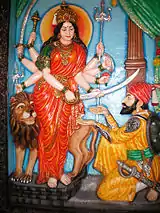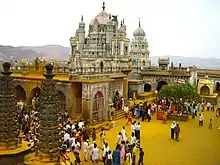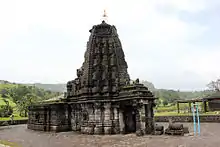Bhavani
Bhavānī (also known as Bhāvya, Tulajā, Turajā, Tvarita, Aṃbā, Jagadambā and Aṃbē. Bhavānī translates to "giver of life", meaning the power of nature or the source of creative energy. She is considered to be a mother who provides to her devotees and also plays the role of dispensing justice by killing Asuras. According to the Śiva Purāṇa, Bhavānī is the supreme goddess and the consort of (Sadāśiva). She is even portrayed as a virgin and unmarried goddess. Bhavānī (भवानि, “the giver of existence”).—One of the names of the Goddess, Devī, who is regarded as the female principle of the divine; the embodiment of the energies of the Gods. Bhavānī (भवानी) is an epithet of the Goddess (Devī), who incarnated as Satī, according to the Śivapurāṇa 2.2.14. Accordingly, as Brahmā narrated to Nārada:—“[...] On seeing the mother of the universe born of Vīriṇī, Dakṣa joined his palms in reverence, paid respects to her, and eulogized her. [...] O mother of the universe, those who eulogize Thee with the names of Bhavānī, Ambikā, Jaganmāyā and Durgā will have everything”. The Goddess has a great variety of names referable to her various forms, attributes, and actions but these names are not always used accurately and distinctively. As the mother of the world, she is Ambikā or Jagaṭ Jananī (the reading Jagaṭ Jananī/Jaga Jananī for Jaganmāyā is preferable). In her fiercer form, she is Durgā, the inaccessible.[1]
| Bhavani | |
|---|---|
Goddess of Power, Goddess of justice, Goddess of Motherhood, Goddess of Emotions | |
.png.webp) Bhavānī riding on her mount lion with 8 arms. | |
| Devanagari | भवानी |
| Affiliation | Shakti, Devi, Adi Parashakti, Mahādevī, Durga, Tridevi-Mahasaraswati, Mahalakshmi, and Mahakali/Parvati |
| Abode | Devī Lōk, Brahmaloka (as Saraswati), Vaikuntha (as Mahalakshmi), and Kailash (as Parvati/ Mahakali) |
| Weapon | Bow and arrow, sword, mace, discus, conch shell, |
| Mount | Tiger/Lion |
| Consort | Trimurti- Brahma, Vishnu, Shiva |
Temples of Bhavani
The Tulja Bhavani temple in Tuljapur in the Osmanabad District of Maharashtra is considered one of the 51 Shakti Pithas (pilgrimage sites). This temple was built close to the 12th century CE. Another Tulja Bhavani temple was constructed between 1537 and 1540 CE in Chittorgarh,[2] located at coordinates 18.011386°N 76.125641°E
In mid-1970s, a temple of goddess Bhavānī and Bhagwati was built at Goregaon, Mumbai by Guruvarya Lt. Śrī Annaji Shelar. The temple is built on a hilltop named Pahadi Bhuikot Killa. It is a beautiful temple, silent and very peaceful. The temple is covered with big Gulmohar trees, once in your feel out of the city chaos. Good place for meditation. Address: Śrī Bhavānī Mātā Sēva Trust, pahadi bhuikot killa, unnat nagar no 1, behind filmistan studio, goregaon west, Mumbai.
History
Worship of the primeval energy, Shakti, in the form of the Mother Goddess is seen in the four Shakti Peethas of Maharashtra: Bhavānī, with her seat at Tuljapur; Mahalakshmi at Kolhapur; Mahamaya Renuka at Mahur; and Saptashrungi at Vani. Śrī Bhavānī Amman is also worshipped in the state of Tamil Nadu (Periyapalayam). Other Shakti temples in the Maharashtra state are those at Ambejogai and Aundh.

The goddess Bhavānī is held in great reverence throughout Maharashtra. She is considered to be an embodiment of ugra' or ferocity, as well as a Karunaswaroopini, an embodiment of mercy. A number of castes, sub-castes, and families from Maharashtra consider her their family deity or Kuladevata. The Bhavani temple in Tuljapur is located on a hill known as Yamunachala, on the slopes of the Sahayadri range in Maharashtra near Solapur. The temple entrance is elevated and visitors ascend a flight of steps to reach the shrine. Historic records speak of the existence of this temple from as early as the 12th century CE. Bhavānī is worshipped in the form of a granite image, 3 feet (0.91 m) tall, with eight arms that hold weapons and one hand in abhayā mūdra (giving blessings to devotees), She kills the demon Mahishasura in 4 different forms which are Kātyāyanī (10-armed), MahaLakshmi (18-armed/1000 armed Devī Ćaṇḍika from Durgā Saptaśatī), Ugraćaṇḍā (18-armed) and Bhadrakālī (16-armed). Legend says that a demon by the name of Matanga wreaked havoc upon the devas and humans, who approached Brahma for help. Upon his advice, they turned to the Mother Goddess Shakti. She took the form of the destroyer and, empowered by the other Saptamātṛka (Brāhmaṇī, Vaiṣṇavī.Māheśvari, Indrāṇi, Kaumārī, Vārāhī, and Ćāmuṇḍā.), vanquished the demon and allowed the restoration of peace. Legend also describes how Bhavānī vanquished another demon who had taken the form of a wild buffalo, Mahishasura (hence her name Mahishasura Mardhini or "the slayer of Mahisha the demon"). Later, she is said to have taken abode on the Yamunachala hill, which is now home to the temple. Bhavānī is said to have come here to save Anubhuti from the demon known as Kukur. In a battle with the goddess, Kukur took the form of a buffalo; Bhavani cut his head, then he started coming in his original form. At that time, she penetrated her trident in his chest. Hence, she is in form of Mahishasura Mardini Durga. Four worship services are offered at the temple each day. The festivals of special significance are Gudi Padwa in the month of Chaitra, Shriral Sashti, Lalita Panchami, Makara Sankranti, and Rathasaptami. The statue of the deity is taken out in procession on Tuesdays. Navaratri is also celebrated with great fanfare, and it culminates in Vijaya Dasami. Sri Bhavani Devi is said to be Adi Parashakti herself and the name Bhavani has several meanings. According to Lalitha Sahasranamam, Bhavānī means the deity who always helps devotees gain mukti. Adi Shankara said, "A Person who recites the name Bhavani with true devotion thrice every day will not acquire sorrow, sin, illness and unexpected death." People occasionally confuse Bhavani devi with Renuka devi; however, their stories are different. There are many texts which name Bhavani as the wife of Shiva (usually in Shaiva-centered texts) like the Uma-Samhita, the wife of Vishnu (usually in Vaishnava-centered texts) like in Lakshmi Tantra, the wife of the Trimurti, or an unmarried virgin (usually seen in some Shakta-centered texts).
Image of Tulja Bhavani
The image (murti ) of Tulja Bhavani is made of black stone, about 3 feet (0.91 m) in height and 2 feet (0.61 m) in width. The face of the goddess is described as beautiful and smiling. The goddess is asta-bhuja (with 8 hands) Durga. Her long hair is coming out of the crown. She has a quiver on her back. The sun and the moon are present. Her lion stands near her. The image is self-manifested and movable. It is moved three times a year from its place to the bedroom of Mā Bhavānī. Below the lion, sage Markandeya is chanting the Durga-saptashati shlokas. The lady sage Anubhuti is on the left side of the goddess; she is in a hanging position and is meditating on the goddess. It is chala murti, moved thrice a year during the long sleeping periods of maa Bhavani. The face of Sati had fallen in Tuljapur, and due to this the face is decorated with sarees and ornaments.
See also
Notes
- [https://www.wisdomlib.org/definition/bhavani}}
- Mewar encyclopedia Archived June 14, 2007, at the Wayback Machine
Further reading
- Hindu Goddesses: Vision of the Divine Feminine in the Hindu Religious Traditions (ISBN 81-208-0379-5) by David Kinsley


